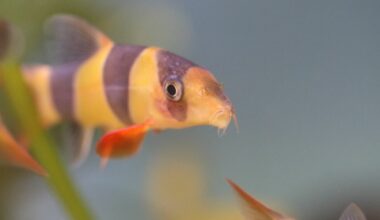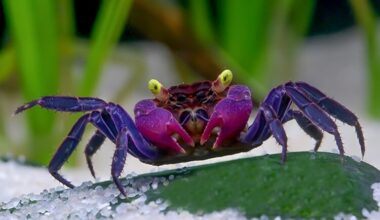Cardinal Sulawesi Shrimp are one of the most underrated species of freshwater shrimp out there. In fact, most aquarists have never even heard of them!
These little critters are a joy to own and look absolutely stunning. We know many owners that wonder why they didn’t take the leap sooner!
But if you’re interested in getting some for your home tank, there are a few things you should know first.
Sulawesi Shrimp care requires a strong understanding of their natural environment and how to replicate it in an aquarium. But don’t worry, by the time you’re done reading this guide you’ll be ready to own some yourself!
Table of Contents
Species Summary
Small, yet vibrant in coloration, the Cardinal Sulawesi Shrimp (scientific name: Caridina dennerli) is a highly sought-after invertebrate in the fish trade.
These dwarf shrimp are very new to the hobby. They were first discovered in 2007.
Because they are still new, there aren’t as many active breeders like there are with other shrimp species. As a result, finding this freshwater shrimp can be difficult. If you do manage to find them for sale, they often come with a high price tag!

Cardinal Sulawesi Shrimp are native to the Sulawesi region in Indonesia. They can be found living in two ancient lakes. These lakes, like other bodies of water in the Sulawesi region, are unique.
Thanks to the distinct water parameters of the area, Cardinal Sulawesi Shrimp can be difficult to care for. They require specific conditions to truly thrive. If you have a bit of experience, these creatures can make excellent additions to your collection.
Lifespan
Cardinal Sulawesi Shrimp live slightly longer than most dwarf shrimp species. In the right conditions, they have a lifespan of up to two years.
That isn’t that long compared to bigger invertebrates in the trade. To make things even trickier, these shrimp are quite sensitive to water parameter changes. To keep them healthy, you have to stay vigilant about maintaining the tank and fulfilling all of the shrimps’ needs.
Appearance
One of the biggest reasons these shrimp are in such high demand is because of their head-turning looks.
The body of the shrimp is similar to that of other dwarf shrimps. They have slender segmented bodies, lengthy antennas, and tiny legs.
However, the coloration is where the Cardinal Sulawesi Shrimp really stands out.
The entire shrimp is covered in a vibrant red hue. Spots of white break up that coloration a bit to create a striking appearance.
Author Note: You’ll notice that antennas and front legs are bright white, too. Some specimen may have pure white tails as well.
Average Size
When you first purchase a Cardinal Sulawesi Shrimp, it will likely be a small juvenile that measures about half an inch in length.
As adults, these shrimp don’t get that much larger. When fully grown most will hover around an inch long.
Cardinal Sulawesi Shrimp Care
Cardinal Sulawesi Shrimp care is no easy task.
The most difficult aspect is creating the right environment for them. These shrimp hail from ancient lakes with conditions that you don’t see that often in other bodies of water around the world.
Thus, they don’t do well in your average tropical fish tank. To help these shrimp reach their full potential, you need to create a separate environment that’s fine-tuned to their needs. Here are some care guidelines that you can follow to make that happen.
Tank Size
Because they are so small, you don’t need a massive tank. In fact, they’re perfect for smaller nano tanks.
Many owners see success keeping these shrimp in tanks that can hold as little as five gallons!
Author Note: That should be fine for a small group. However, we always recommend getting something larger if possible.
A larger aquarium will make it easier to regulate conditions. Smaller tanks are notorious for turning quickly when it comes to water parameters. With more water, you can keep things a bit more stable.
Water Parameters
When you’re caring for Cardinal Sulawesi Shrimp, you must recreate their natural environment as much as possible. This can be difficult because the region has distinct water parameters.
The ancient lakes these freshwater shrimps come from are warm and a bit alkali. They’re not salty enough to be considered brackish.
However, the higher pH level is something that most aquarists are not used to.
Before you add the shrimp into the tank, make sure that it’s fully cycled and ready to go. Triple-check the pH balance and hardness to ensure that the shrimp do not go into shock.
Here are the established parameters you need to follow:
- Water temperature: 77°F to 88°F (temperatures in the middle of this range are ideal)
- pH levels: 7.0 to 8.5 (approximately 8.0 is best for true Sulawesi conditions)
- Water hardness: 3 to 10 dKH
In order to stay informed and accurately maintain the water parameters in the tank, perform regular tests with a reliable aquarium test kit. Do this roughly twice a week for the best results (there’s no point going overboard).
What To Put In Their Tank
Take a look at any photo of the Sulawesi region and you’ll see that it’s very biologically diverse. The waters are teeming with life!
You should do your best to recreate that natural environment in your aquarium.
Start with a layer of dark sandy substrate at the bottom of the tank. This mimics the layer of plant detritus on the bottom of the shrimp’s natural habitat.
On top of the substrate, add some rocks and driftwood. Stick with porous surfaces rather than ultra-smooth ones. A porous rock will easily become home to algae. The same goes for rough driftwood.
You can introduce some plants throughout the aquarium as well. The live plants will serve as a source of food for the shrimp. It can also help provide shelter from the light.
For equipment, you’ll need all of the standard fares. Use a filter that’s efficient for the size of the tank, but be sure that the outlet is soft.
Author Note: Cardinal Sulawesi Shrimp prefer calm waters, so you may need to utilize sponges to minimize water disturbance.
Lighting should be kept to a minimum. These shrimp are active at all hours of the day. But they are sensitive to strong light.
Frequent Potential Diseases
Currently, there aren’t any diseases that are known to affect this species specifically. But, that doesn’t mean your shrimp is in the free and clear. They can suffer from all of the major diseases that other freshwater shrimp can experience.
One of the most common issues with Cardinal Sulawesi Shrimp is stress. Poor water conditions can cause the shrimp to become stressed, which opens up the possibilities of bacterial, fungal, and parasitic infections.
The tricky thing about dealing with those issues is that you can’t use copper-based medicines.
Like other invertebrates, these shrimp do not handle copper well. Thus, you’ll have to turn to natural treatments if your shrimp comes down with a disease.
The best way to deal with diseases is to avoid them in the first place! Keep the tank clean and continually monitor water conditions.
Avoid performing water changes too frequently. This might seem like surprising advice, but there’s a good reason for it. If you have a well-cycled tank, your filter should be able to take care of nitrates and ammonia efficiently. Frequent water changes will only shock the shrimp.
Food & Diet
Cardinal Sulawesi Shrimp are very easy to please. Their main diet in the wild consists of decaying plant matter, algae, and biofilm. In captivity, those same things should be diet staples!
That’s why it’s so important to incorporate things like rocks and driftwood. These shrimp are great algae-eaters and will survive mainly on algae and biofilm that grow in the tank, so embrace that natural mess.
If your aquarium is well-maintained you may not have to provide supplemental food at all! If you do, you can use powdered spirulina or other micro-organisms.
Behavior & Temperament
At first, Cardinal Sulawesi Shrimp are very shy. When first introduced to a tank, they will spend most of their time in hiding.
You can find them taking cover under rocks, in plant leaves, and anywhere else they can find shelter.
This is perfectly normal. Most shrimp of this size will exhibit some skittishness.
Over time, your Cardinal Sulawesi Shrimp should get more comfortable with the environment. When that happens, you’ll find them scavenging for food around the clock. They are constantly searching and eating different types of aquarium algae!
As for temperament, you shouldn’t encounter any problems at all. They do well with other shrimp and usually don’t cause any trouble.
Tank Mates
Let’s be clear, it’s not easy finding suitable tank mates for these shrimp.
The reason for that is their distinct needs. In most cases, standard community fish species will not tolerate the high pH balance.
The best tankmates are going to be creatures that come from the same area. You can keep these shrimp in large groups. Other Sulawesi dwarf shrimp make fine tankmates as well. The same goes for Sulawesi snails.
Breeding
There are concerted efforts to breed these shrimp in captivity and improve availability in the trade. While it’s relatively easy to breed the shrimp, it takes a lot of time!
Cardinal Sulawesi Shrimp lay fewer eggs. Plus, they have an overall lower breeding rate.
The good news is that you can easily start a small colony in your tank without doing a ton of extra work. As long as you have a male and female in the same tank, they will more than likely spawn at some point. This is great because separating the males and females isn’t easy!
Once they have bred, the female will lay about 15 eggs. She’ll keep them in her swimmerets, which are tiny leg-like finds on the underside of the body. She’ll keep those eggs there throughout the entire incubation process.
After about 20 days, the eggs will hatch and swim free. Provide them with finely powdered food as they grow.
Now You’re Ready To Go!
Now that you know what’s required if you want to provide excellent Sulawesi Shrimp care, there’s nothing stopping you from buying some!
These creatures are absolutely gorgeous and looking at them never gets old. The rich red color stands out in even the smallest tanks.
If you have some more questions about this freshwater species we’re always happy to help. Just shoot us a message through our website or social media and we’ll answer you as soon as we can!

